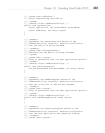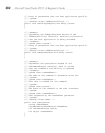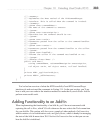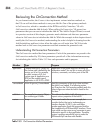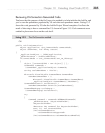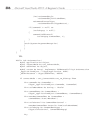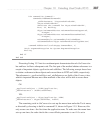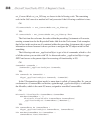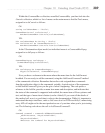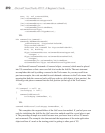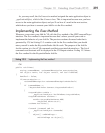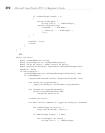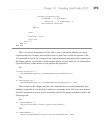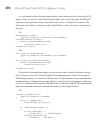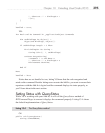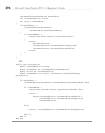
Chapter 13: Extending Visual Studio 2010 389
Within the CommandBars collection, menuBarCommandBar, you then look into the
Controls collection, which is a list of menus on the main menu to find the T
ools menu,
assigned to toolsControl as follows:
C#:
string toolsMenuName = "Tools";
CommandBarControl toolsControl =
menuBarCommandBar.Controls[toolsMenuName];
VB:
Dim toolsMenuName As String = "Tools"
Dim toolsControl As CommandBarControl =
menuBarCommandBar.Controls.Item(toolsMenuName)
In the VS automation object model, an individual menu is a CommandBarPopup,
assigned to toolsPopup as follows:
C#:
CommandBarPopup toolsPopup =
(CommandBarPopup)toolsControl;
VB:
Dim toolsPopup As CommandBarPopup =
CType(toolsControl, CommandBarPopup)
Now you have a reference to the menu where the menu item for the Add-In must
be added. You are ready to add the command, using the AddNamedCommand2 method
of the commands collection. Remember that earlier code assigned these commands
from the application object to the commands variable. A quick review of the arguments
to AddNamedCommand2 gives you the gist of what’s happening: The code passes a
reference to the Add-In; provides a menu item name and description; and indicates that
the status of the command is supported and enabled, the menu item will have pictures and
text, and the type of menu item is button (can be clicked). If you want all the details of
this method call, now is a good time to refer to the documentation. While it’
s important to
understand the major interfaces, such as OnConnection for IDTExtensibility2, memorizing
every API call might not be the most productive use of your time when you’re just starting
out. The following code shows the call to AddNamedCommand2:
C#:
Command command = commands.AddNamedCommand2(
_addInInstance, "KeystrokeFinder",
"KeystrokeFinder",
"Executes the command for KeystrokeFinder",



